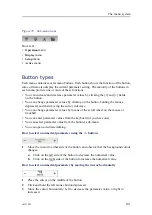
Simrad ES70
About output power
The echo sounder’s transducer converts the electrical input power to a sound transmitted
into the water. In the majority of the transducers manufactured by Simrad the
transducer’s
power efficiency
is between 50 and 75%. This means that between 50 and
75% of the input power is transmitted as sound. Transducers from other manufacturers
may have as low as 5% power efficiency. Naturally, it is very important that you check
this parameter when you wish to purchase a transducer.
The echo sounder’s
output power
is a measurement on how much electrical energy
the amplifier can send down to the transducer. The maximum power is limited by
the transducer you have, and how much power it may accept from the transmitter for
conversion to acoustic energy. If you send too much power into the transducer, you may
inflict permanent and unrepairable damage.
The
source level (SL)
is a measurement on how much acoustic energy that is in fact sent
out by the transducer, how high “volume” it will emit. The source level is measured as
“sound pressure” one meter below the transducer face, and it is given i
dB re. 1µPa at
1 m
.
In order to know how much power you can use you must know what kind of transducer
you are using. Provided that the echo sounder has been installed with a Simrad
transducer, and you know what type it is, this is no problem. All necessary parameters
about the transducer are then known by the echo sounder, and the software in the sounder
will ensure that you do not output too much power. If you use a third party transducer
you must manually check that the output power from the Simrad ES70 does not exceed
the power rating.
Note
If you send too much power into the transducer it will – just like a loudspeaker – be
damaged beyond repair.
If the transducer receives too much power from the echo sounder, it will also
cavitate
.
This is a physical phenomenon causing the appearance of gas bubbles immediately
below the transducer face. When this happens hardly any energy is sent into the water,
and the transducer face is subject to physical damage. The cavitation depends on the
power applied, the physical size of the transducer face, how deep the transducer is
mounted, and the amount of contamination (air and particles) under the transducer face.
Transducers with a large face can accept more power.
Near sea level, minute bubbles of micron or submicron size are always present in
the ocean. When the rarefaction tension phase of an acoustic wave is great enough,
the medium ruptures or "cavitates". For sound sources near the sea surface, the
ever-present cavitation nuclei permit rupture to occur at pressure swings of the order
of 1 atm (0.1 MPa), depending on the frequency, duration, and repetition rate of the
sound pulse. Cavitation bubbles may also be produced by Bernoulli pressure drops
associated with the tips of high-speed underwater propellers. Natural cavitation
is created by photosynthesis.
112
343539/B
Summary of Contents for ES70 - DOWNLOAD AND INSTALLATION REV B
Page 2: ......
Page 128: ...ISBN 13 978 82 8066 118 0 2010 Kongsberg Maritime AS ...































